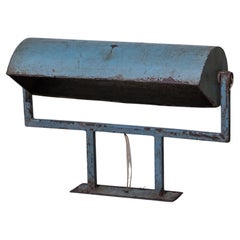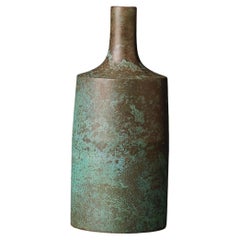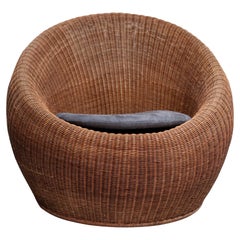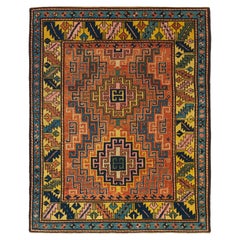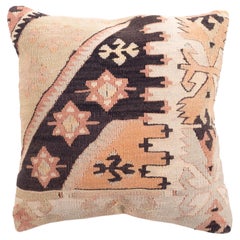Japan - Furniture
to
548
508,957
446,304
1,987
1,325
26
187
137
109
10
8
4
3
3
2
2
1
1
138
384
1,465
1,351
459
517
271
7
8
13
22
26
107
112
84
76
23
1,117
831
785
764
763
2,744
1,928
1,890
707
706
3,338
3,245
3,279
289
58
41
34
33
Item Ships From: Japan
Wall Light by Le Corbusier for Chandigarh, India, Circa 1954-55
By Le Corbusier
Located in Tokyo, JP
An authentic mid-century piece from Le Corbusier’s legendary Chandigarh commission. Shade and base made of iron.
Category
Mid-20th Century Indian Mid-Century Modern Japan - Furniture
Materials
Iron
Japanese Framed Silk Painting, Turtledoves and Peaches, Taisho Era, circa 1920
Located in Kyoto, JP
Nakamura Daizaburo
Turtledoves in a Peach Tree
Taisho period, circa 1920
Framed painting. Mineral pigments, ink and gofun on silk
Signed: Daizaburo
Dimensions (framed)...
Category
1910s Japanese Taisho Vintage Japan - Furniture
Materials
Wood, Silk
Unique Signed Japanese Bronze Vase by Hara Masaki – Showa Period
Located in Fukuoka, JP
A finely cast green-patinated bronze vase by the acclaimed Japanese artist Hara Masaki (1935–2011), known for his refined forms and subtle surface finishes.
This piece stands out for...
Category
20th Century Japanese Showa Japan - Furniture
Materials
Bronze
Rattan Lounge Chair by Isamu Kenmochi for Yamakawa Rattan, 1960s, Japan
By Isamu Kenmochi
Located in Tokyo, Tokyo
A beautifully crafted rattan lounge chair by Isamu Kenmochi, one of Japan’s foremost modernist designers. This piece reflects Kenmochi’s celebrated approach of merging traditional Ja...
Category
Mid-20th Century Japanese Japan - Furniture
Materials
Rattan
Ararat Rugs Kazak Rug with Hooked Medallions Antique Revival Carpet Natural Dyed
By Ararat Rugs
Located in Tokyo, JP
This is a complete hooked field with double medallions rug from the late 19th century, Kazak region, Caucasus area. A striking field design features two medallions each with concentr...
Category
21st Century and Contemporary Turkish Revival Japan - Furniture
Materials
Wool, Natural Fiber, Organic Material
Vintage & Old Kilim Cushion Cover, Anatolian Yastik Turkish Modern Pillow 4421
Located in Tokyo, JP
This beautifully handcrafted cushion cover is made from a vintage Anatolian kilim—once part of a traditional yastik, or small decorative rug used in Turkish homes. Woven in the mid-2...
Category
2010s Turkish Kilim Japan - Furniture
Materials
Natural Fiber, Organic Material
$144 Sale Price
20% Off
Japanese vtg low table. solid hardwood tabletop & antique leg frame. wabi sabi
Located in 常陸大宮市, JP
Japanese antique low dining table / Kotatsu (heated table) for 4 people.
Tabletop material is made of single solid hardwood, original paint remains on the backside, which gives anoth...
Category
Early 20th Century Japanese Showa Japan - Furniture
Materials
Hardwood, Cedar
Circa 1700 Japanese Sliding Door (Fusuma) Set. Pine Trees on the Seashore.
Located in Kyoto, JP
"Pine Trees on the Seashore"
A set of four sliding doors (Japanese fusuma). Ink, color, gold-leaf and gold-fleck on paper.
Dimensions (total display si...
Category
Late 17th Century Japanese Edo Antique Japan - Furniture
Materials
Gold Leaf
Floor Lamp Luci 70s 80s Italian modern Stilnovo style
By Stilnovo, luci
Located in Shibuya-ku, Tokyo
Floor lamp designed by STD for Luci. Designed and published probably in the late 70s or early 80s. White painted body. Shade is made of plastic and stainless.
Shade can tilt upward...
Category
1980s Italian Post-Modern Vintage Japan - Furniture
Materials
Steel
Japanese Antique sofa side table, Wabi Sabi, Japandi
Located in Katori-Shi, 12
A simple yet powerful and elegant round table.
The soft wood grain of cherry wood and the beautiful aged texture of the base material combine to create a quiet presence.
The origina...
Category
Early 20th Century Japanese Taisho Japan - Furniture
Materials
Wood
Glass Showcase, Storage shelves, Japanese Antiques, Wabi Sabi, Japandi
Located in Katori-Shi, 12
We have completed a special showcase that represents the best of ICCA's craftsmanship.
The main material is chestnut, which has beautiful grain and durability.
It was disassembled i...
Category
Early 20th Century Japanese Taisho Japan - Furniture
Materials
Wood
Japanese Painting, Hanging Scroll, 'Playful Cat' by Hirose Toho, 1920s Taisho
By Hirose Toho
Located in Kyoto, JP
Playful Cat
Hirose Toho (1875-1930)
Hanging scroll, ink, mineral pigments and gofun on silk.
Painting inscription: Toho Sha
Painting seals:
Upper - Hirose Hitoshi
Lo...
Category
1920s Japanese Taisho Vintage Japan - Furniture
Materials
Silk
Italian Sideboard 1950's
Located in Shibuya-ku, 13
Estimated to be from the 1950s, this Italian vintage sideboard embodies a distinctive fusion of retro charm and futuristic design—a hallmark of mid-century Italian aesthetics. The bo...
Category
1950s Italian Mid-Century Modern Vintage Japan - Furniture
Materials
Glass, Maple, Teak
$4,400 / item
Exceptional Pair of Japanese Hibachi with Makie Lacquer – Edo to Meiji Period, 1
Located in Fukuoka, JP
A superb and one-of-a-kind pair of large Japanese hibachi (charcoal braziers), crafted from kiri wood and richly decorated with makie gold lacquer. The surfaces are adorned with eleg...
Category
19th Century Japanese Edo Antique Japan - Furniture
Materials
Wood, Lacquer
Semi Old Vintage Handwoven Wool Mut Kilim Central Anatolian Rug Turkish Carpet
Located in Tokyo, JP
This is a South Anatolian Vintage / Semi-old Handwoven Kilim from the town of Mut in Mersin Province, located in the Mediterranean region of Anatolia, Turkey. These kilims are renown...
Category
Late 20th Century Turkish Kilim Japan - Furniture
Materials
Wool, Natural Fiber
$376 Sale Price
20% Off
Wooden Low Table, Japanese Antique, Wabi-Sabi, Mingei
Located in Katori-Shi, 12
We will introduce a low table that exudes the charm of the Meiji era.
The low table was loved by craftsmen as a "cutting stand" during the Meiji era.
Cherry wood with a rich textur...
Category
Early 20th Century Meiji Japan - Furniture
Materials
Wood
Japanese Antique BK Drawer 1860s-1900s / Storage Tansu Wabi Sabi
Located in Sammu-shi, Chiba
Very old Japanese drawer storage.
The furniture is from the Meiji period (1860s-1900s).
The main material is cedar wood.
The handles are made of iron.
The design is ultimately simpl...
Category
Early 20th Century Japanese Meiji Japan - Furniture
Materials
Cedar
The sky visible at Honmonji TempleⅣ by Blue Tip Atelier
Located in Sammu-shi, Chiba
Title : The sky visible at Honmonji TemplⅣ
Japan / 2024s
Size : W 275 H 395mm
A mini series of the sky as seen from Honmonji Temple.
Natural dyes used are Indian madder and oak g...
Category
2010s Japanese Modern Japan - Furniture
Materials
Linen
Contemporary Large Japanese Green Blue Gilded Porcelain Vase by Master Artist
Located in Takarazuka, JP
Outstanding contemporary large Japanese porcelain vase featuring a fascinating and detailed geometric progression that is hand painted in...
Category
21st Century and Contemporary Japanese Japan - Furniture
Materials
Gold
Japanese Contemporary Red Black Silk Folding Screen, 2
Located in Takarazuka, JP
Outstanding Japanese contemporary two panel "byobu" or folding screen featuring genryoku style handcrafted raised pure silk kimono in black, red and gold on textured black background...
Category
21st Century and Contemporary Japanese Meiji Japan - Furniture
Materials
Gold
Japanese Antique Bench Long chair Primitive Japandi Wabi-Sabi
Located in Chiba, Chiba
This is an old Japanese bench.
It's a simple, rustic bench, but the patina that comes with years of use gives it a nice look.
In addition to sitting on it, I think it can also be use...
Category
Mid-20th Century Japanese Japan - Furniture
Materials
Wood
Giotto Stoppino Glass Top Chrome Round Table 1970's
By Giotto Stoppino
Located in Shibuya-ku, 13
This stunning glass-top table is a creation by renowned Italian designer Giotto Stoppino, celebrated for his bold and forward-thinking approach to modern design.
The table’s distinct...
Category
1970s Italian Mid-Century Modern Vintage Japan - Furniture
Materials
Chrome
Private Table, Coffee table, Japanese Antique (Small)
Located in Katori-Shi, 12
This is our original small round table, "PRIVATE TABLE".
We carefully disassembled the usable parts of antique furniture that had outlived their usefulness, and breathed new life in...
Category
2010s Japanese Taisho Japan - Furniture
Materials
Wood
Japanese Stone Object medium / wabi-sabi
Located in Sammu-shi, Chiba
This is an old Japanese stone object.
This stone object has a beautiful black and beige gradation.
An art object that gives you a sense of wabi-s...
Category
15th Century and Earlier Japanese Japonisme Antique Japan - Furniture
Materials
Stone
Ryosuke Harashima Contemporary Zen wood wall sculpture
By Ryosuke Harashima
Located in Shibuya-ku, Tokyo
Name: A Blind on the Pine Tree
Wall sculpture made of J brass, Ranma(Japanese antique transom).
Artist statement
Draw a line through the landscape car...
Category
2010s Japanese Japonisme Japan - Furniture
Materials
Brass
Old Japanese wooden wall hanging object/wooden mold/20th century
Located in Sammu-shi, Chiba
This is an old Japanese wooden mold, probably made in the 20th century during the Showa period. I don't know what it was used for, but it has a unique texture as a traditional tool u...
Category
20th Century Japanese Showa Japan - Furniture
Materials
Wood
Pair of Gilded Japanese Shokudai Candle Holders – Edo to Meiji Period, 19th C
Located in Fukuoka, JP
A fine pair of traditional Shokudai candle holders used in Buddhist temples, dating to the late Edo to early Meiji period (19th century).
Carved from wood and finished in gold leaf, ...
Category
Early 19th Century Japanese Edo Antique Japan - Furniture
Materials
Belgian Black Marble, Gold Leaf
Japanese antique two-piece stone statue of a monk/God of the road/Edo period
Located in Sammu-shi, Chiba
We have a rare stone Buddha in stock.
This is a small twin-figure stone carving made in the early to middle Edo period (1600–1800). It features two standing monk-like deities side b...
Category
18th Century Japanese Edo Antique Japan - Furniture
Materials
Stone
Old wooden bowl with legs from Southeast Asia/20th century/Object
Located in Sammu-shi, Chiba
This is believed to be an old wooden ball with a stand made in Southeast Asia around the 20th century. Having survived to the present day after many years, this ball is attractive fo...
Category
20th Century Southeast Asian Other Japan - Furniture
Materials
Wood
Japanese Old Galvanized Iron 1920s-1940s / Abstract Art Object Wabisabi
Located in Chōsei District Nagara, JP
This is an old Japanese tin. It has been lying in this condition in an old warehouse for many years.
Judging from the texture and feel, it is estimated to have been manufactured in t...
Category
Mid-20th Century Japanese Showa Japan - Furniture
Materials
Tin
Tapio Wirkkala / HOURGLASS L / Vakumotuote Oy
By Tapio Wirkkala
Located in Shibuya-Ku, JP
This acrylic cube-shaped hourglass was created in 1980 to commemorate the 60th anniversary of the Mannerheim Child Welfare Association.
In Finnish, ‘Hetkinen Lapselle’ means ‘Time fo...
Category
1980s Finnish Scandinavian Modern Vintage Japan - Furniture
Materials
Acrylic
Semi Old Vintage Handwoven Wool Mut Kilim Central Anatolian Rug Turkish Carpet
Located in Tokyo, JP
This is a South Anatolian Vintage / Semi-old Handwoven Kilim from the town of Mut in Mersin Province, located in the Mediterranean region of Anatolia, Turkey. These kilims are renown...
Category
Late 20th Century Turkish Kilim Japan - Furniture
Materials
Wool, Cotton, Natural Fiber
$456 Sale Price
20% Off
Lounge Armchair by “Audoux-Minet”
By Adrien Audoux and Frida Minnet
Located in Sammu-shi, Chiba
Lounge Arm Chair by "Audoux-Minet"
Adrien Audoux & Frida Minet met in the Provence region of France during the 1940s and began collaborating on design projects. Their work reflects ...
Category
Mid-20th Century French Mid-Century Modern Japan - Furniture
Materials
Rush, Wood
Vintage & Old Kilim Cushion Cover, Anatolian Yastik Turkish Modern Pillow 4356
Located in Tokyo, JP
We made a cushion cover using the undamaged parts of the precious and high-quality old & antique kilims that cannot be repaired. Like a painting, a part of the scenery is cut out fro...
Category
2010s Turkish Kilim Japan - Furniture
Materials
Natural Fiber, Organic Material
$120 Sale Price
20% Off
Antique Caucasian Runner Rug, Caucasus Carpet
Located in Tokyo, JP
This is an antique runner rug from the Caucasus region with a rare and beautiful color composition.
Of all the rugs of the oriental world, it is the work of the Caucasian weavers ...
Category
Early 20th Century Caucasian Oushak Japan - Furniture
Materials
Wool, Natural Fiber
Italian Dining Chair 1950's
Located in Shibuya-ku, 13
Italian vintage is characterized by smart and beautiful frames, and this dining chair perfectly embodies that style. It features elegant proportions and intricate design elements, of...
Category
1950s Italian Mid-Century Modern Vintage Japan - Furniture
Materials
Fabric, Wood
$4,400 / set
Japanese Painting. Bird and Flower. 19th century copy of Lu Ji by Ogata Tomin.
Located in Kyoto, JP
Ogata Tomin (1839 -1895)
Birds in a spring landscape
Ink and colour on silk.
Inscription reads:
“Copy of Lu Ji, painted with heartfelt appreciation”
“Painted by Tomin Ogat...
Category
Late 19th Century Japanese Ming Antique Japan - Furniture
Materials
Silk
Set of Three Imari Porcelain Bowls – Late Edo to Early Meiji, 19th Century
By Imari Porcelain
Located in Fukuoka, JP
A fine and charming set of three hand-painted Imari porcelain bowls, dating to the late Edo to early Meiji period (19th century). Each bowl features traditional underglaze blue and o...
Category
19th Century Japanese Edo Antique Japan - Furniture
Materials
Ceramic
Japanese Antique Tansu / Cabinet Drawer Night Table / 1868-1912s / Wabi-Sabi
Located in Iwate-gun Shizukuishi-cho, Iwate Prefecture
This is an old Japanese drawer.
It is a type with a deeper drawer than a normal drawer.
It is estimated that it was made around the Meiji period.
The material is made of cedar.
C...
Category
Late 19th Century Japanese Meiji Antique Japan - Furniture
Materials
Wood, Cedar
Italian Marble Top Round Table 1960's
Located in Shibuya-ku, 13
The gentle hues of marble (marble) create an elegant atmosphere in any room. With its sleek leg design, it easily harmonizes with a variety of furniture and interiors, whether classi...
Category
1960s Italian Mid-Century Modern Vintage Japan - Furniture
Materials
Marble
Japanese antique small box chest of drawers, 1916. Taisho wabi sabi urushi tansu
Located in 常陸大宮市, JP
108 years-old wooden small tansu (chest of drawers) with 4 drawers.
Finished with traditional Urushi lacquer. The original laquer remains well & gives a good wabi sabi touch.
Each handles are partly covered with Boro (hand-woven, indigo dyed cotton cloth) - this is another wabi sabi element of this tansu.
Smooth opening & closing operation for all drawers.
Product of Taisho 5 (1916), written on the bottom together with maker's address & name.
drawer inner w 5.79 in / d 12.6 in / h 1.38 in, 1.69 in, 2.28 in, 2.64 in (from the top)
actual item weight 5.95 lb (2.7 kg)
***
We're eco-friendly, organic-oriented vintage wood furniture...
Category
Early 20th Century Japanese Taisho Japan - Furniture
Materials
Wood, Cedar
$360 Sale Price
28% Off
Japanese Contemporary Framed Brocade Silk Handcrafted Oshie Decorative Art, 2
Located in Takarazuka, JP
Extraordinary unique Japanese Contemporary large framed and signed traditional Oshie decorative art piece in black and cream, known as oshie (literally, “pressed pictures”) that goes back to the Edo Period (1603-1868). It is said this art form was born of the reluctance of ladies of the court and elite aristrocratic women to discard the magnificent silk kimonos and brocaded obi they had donned for a lifetime. The solution was to recycle these opulent fabrics into stunning works of art. The creator of this signed piece prides herself in using the best antique and vintage kimono and obi fabrics...
Category
21st Century and Contemporary Japanese Meiji Japan - Furniture
Materials
Brocade, Silk
Japanese Antique Table, Desk, Double-sleeved desk, Wabi-Sabi, Early 20th Century
Located in Katori-Shi, 12
This antique Japanese table was produced in the Taisho period (1912-1926).
This is a double-sleeved desk whose lacquer has gained a deep flavo...
Category
Early 20th Century Taisho Japan - Furniture
Materials
Wood
Japanese Old Wooden Object / Wooden Lump Figurine / Wabi-Sabi
Located in Iwate-gun Shizukuishi-cho, Iwate Prefecture
This is an old wooden object.
The details of the tree are unknown, but it seems to be hardwood.
It changes its shape and color over time, and it has become an artistic appearance.
...
Category
Early 20th Century Japanese Primitive Japan - Furniture
Materials
Wood, Hardwood
Japanese Contemporary Brocade Silk Handcrafted Framed Oshie Decorative Art
Located in Takarazuka, JP
Exquisite Japanese contemporary framed oshie wall decorative art piece, recreating a famous painting from Meiji period featuring a Japanese dancer holding a net with cherry blossom ...
Category
21st Century and Contemporary Japanese Meiji Japan - Furniture
Materials
Brocade, Silk
Antique Japanese Wood Bucket , Ocject, Wabi-Sabi
Located in Katori-Shi, 12
This is an antique water bucket from the Taisho period (1912-1926).
The beautiful wood grain and stately iron bands that evoke a sense of histor...
Category
Early 20th Century Japanese Taisho Japan - Furniture
Materials
Wood
Old Japanese Scholar's Stone / Beautiful Appreciation Stone/Natural Stone
Located in Sammu-shi, Chiba
This is a stone mined in Japan. Measure: w 22cm.
Not only in China but also in Japan from ancient times, rocks in the mountains have been shaved and stones for viewing have been qua...
Category
Early 20th Century Japanese Showa Japan - Furniture
Materials
Stone
Ararat Rugs Akstafa Kazak Rug - 19th C. Caucasian Revival Carpet Natural Dyed
By Ararat Rugs
Located in Tokyo, JP
Origin and Inspiration:
This stunning revival of the Akstafa Kazak Rug is a modern creation deeply rooted in the rich weaving traditions of the Caucasus, specifically inspired by the...
Category
21st Century and Contemporary Turkish Revival Japan - Furniture
Materials
Wool, Natural Fiber, Organic Material
X-leg Easy Sofa 3-Seater by Pierre Jeanneret for Chandigarh, India, Circa 1960
By Pierre Jeanneret
Located in Tokyo, JP
An authentic mid-century piece from Pierre Jeanneret’s legendary Chandigarh commission. Teak frame with fabric upholstered seat & back.
Category
Mid-20th Century Indian Mid-Century Modern Japan - Furniture
Materials
Fabric, Teak
Japanese Antiques 2panels, Silver back, Banana Plants, Rofuu folding Screen
Located in Niiza, JP
Material: Silver paper, wooden frame
One sheet: W870×H1740mm, unfolded size: W1740mm, 5kg
Folded size: W870×H1740×D35mm
Estimated packaging (sandwiched with 5mm plywood): 10cm x 100c...
Category
19th Century Japanese Antique Japan - Furniture
Materials
Paper
Very old Chinese pottery jar/Tang Dynasty/unearthed pottery/grave goods
Located in Sammu-shi, Chiba
This is a very old excavated pottery made around the Tang Dynasty in China.
During the Tang Dynasty, colored pottery called Sancai appeared.
There are various colors such as yellow,...
Category
15th Century and Earlier Chinese Tang Antique Japan - Furniture
Materials
Pottery
18th Century Japanese Screen Pair. Plum & Young Pines. Kano School.
Located in Kyoto, JP
Dimensions (Each screen): H. 176 cm x W. 378 cm (69’’ x 149’’)
This pair of Japanese folding screens depict blossoming plum trees amongst young pines. They are designed to capture t...
Category
Late 18th Century Japanese Edo Antique Japan - Furniture
Materials
Gold Leaf
Japanese Antiques 6panels, Gold back, crane and pine, Araki Jippo folding screen
Located in Niiza, JP
Material: gold background paper, wooden frame
One piece: W730 x H1760 mm, unfolded size: W4420 mm, 13 kg
Folded size: W750 x H1760 x D100 mm
Estimated packaging (sandwiched with 5 mm...
Category
Early 20th Century Japanese Japan - Furniture
Materials
Paper
Japanese Contemporary Ko-Imari Gold Blue Porcelain Koro Incense Burner
Located in Takarazuka, JP
Stunning contemporary Japanese Ko-Imari style porcelain koro or incense burner or jewelry box, hand painted on a beautifully shaped round body in cobalt blue, red and green and gener...
Category
21st Century and Contemporary Japanese Meiji Japan - Furniture
Materials
Gold
Antique Asian copper bucket "tsurube" /20th century/hanging flower vase
Located in Sammu-shi, Chiba
This is believed to be a bronze "tsurube" (water bucket) made in Japan or East Asia.
It was likely used to draw water from wells.
The base shows dents, possibly from repeated impacts...
Category
20th Century East Asian Other Japan - Furniture
Materials
Copper
Wilhelm Kåge / ARGENTA VASE / Gustavsberg / 1941
By Wilhelm Kage, Gustavsberg
Located in Shibuya-Ku, JP
Wilhelm Kage studied painting at art school and worked as a poster artist after graduation.
As art director of Gustavsberg from 1917, he laid the foundations for modern design in Swe...
Category
1940s Swedish Scandinavian Modern Vintage Japan - Furniture
Materials
Stoneware
Japanese Screen Painting, circa 1700 'Horses' by Kano Tanshin
Located in Kyoto, JP
Horses
Kano Tanshin Morimasa (1653-1718)
Two-panel tea-ceremony Japanese screen or furosaki
Ink on gold leaf,
late 17th-early 18th century
Measures: H 55 cm x W 182 cm
The Kano school was closely aligned with the warrior class in Japan. The samurai, who lived in a closed and rigid hierarchical society established by the Shogunate, were drawn to the energy and freedom horses symbolize; Kano school artists commonly depicted the equine creatures as they are here, in unfettered and carefree family groups. China originally introduced horse paintings to Japan; the works typically focused on capturing the essence of horses in their various environments and often involved integrating human figures into the images.
Kano Tanshin Morimasa (1653-1718) was the son of Kano Tanyu...
Category
1690s Japanese Edo Antique Japan - Furniture
Materials
Gold Leaf
Japanese Antique Open shelf, Wabi Sabi, Japandi
Located in Katori-Shi, 12
This antique is just the right size for a storage shelf.
This is a rare shelf with flap doors that has a Japanese essence.
A flap door is a door that can be opened and stored insid...
Category
Early 20th Century Japanese Taisho Japan - Furniture
Materials
Wood
Japanese Antique Flap door storage shelf, Wabi Sabi, Japandi
Located in Katori-Shi, 12
A four-tier flap-door shelf from the Taisho period.
In addition to the four main tiers, the shelf also has separate base and crown, making it a total of six parts, making it easy to...
Category
Early 20th Century Japanese Taisho Japan - Furniture
Materials
Wood
Ararat Rugs Village Theme Azeri Folk Life Rug, Turkish Carpet, Natural Dyed
By Ararat Rugs
Located in Tokyo, JP
This unique design rug is interpreted by our designers with a composition of pictorial village life.
Color summary: 9 colors in total;
Jericho Jade 25 (Spurge – Indigo)
Lucario Blu...
Category
21st Century and Contemporary Turkish Oushak Japan - Furniture
Materials
Natural Fiber, Wool, Organic Material
